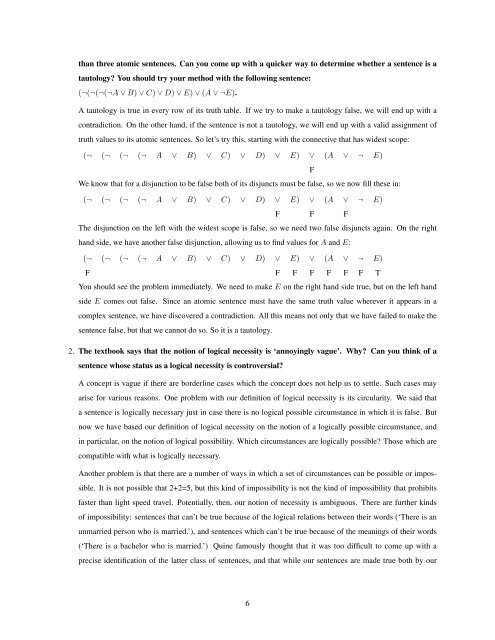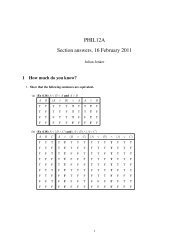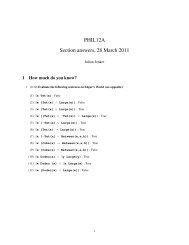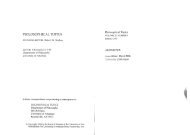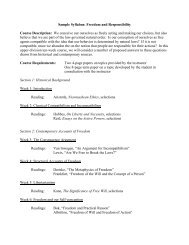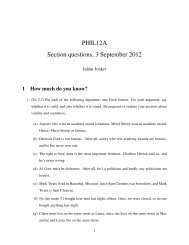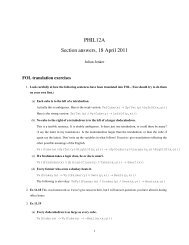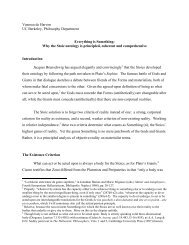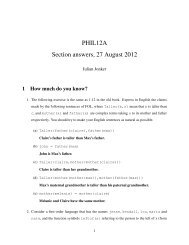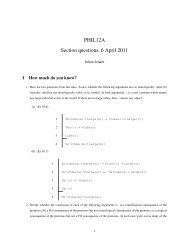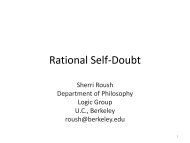PHIL12A Section answers, 14 February 2011 - Philosophy
PHIL12A Section answers, 14 February 2011 - Philosophy
PHIL12A Section answers, 14 February 2011 - Philosophy
You also want an ePaper? Increase the reach of your titles
YUMPU automatically turns print PDFs into web optimized ePapers that Google loves.
than three atomic sentences. Can you come up with a quicker way to determine whether a sentence is atautology? You should try your method with the following sentence:(¬(¬(¬(¬A ∨ B) ∨ C) ∨ D) ∨ E) ∨ (A ∨ ¬E).A tautology is true in every row of its truth table. If we try to make a tautology false, we will end up with acontradiction. On the other hand, if the sentence is not a tautology, we will end up with a valid assignment oftruth values to its atomic sentences. So let’s try this, starting with the connective that has widest scope:(¬ (¬ (¬ (¬ A ∨ B) ∨ C) ∨ D) ∨ E) ∨ (A ∨ ¬ E)FWe know that for a disjunction to be false both of its disjuncts must be false, so we now fill these in:(¬ (¬ (¬ (¬ A ∨ B) ∨ C) ∨ D) ∨ E) ∨ (A ∨ ¬ E)F F FThe disjunction on the left with the widest scope is false, so we need two false disjuncts again. On the righthand side, we have another false disjunction, allowing us to find values for A and E:(¬ (¬ (¬ (¬ A ∨ B) ∨ C) ∨ D) ∨ E) ∨ (A ∨ ¬ E)F F F F F F F TYou should see the problem immediately. We need to make E on the right hand side true, but on the left handside E comes out false. Since an atomic sentence must have the same truth value wherever it appears in acomplex sentence, we have discovered a contradiction. All this means not only that we have failed to make thesentence false, but that we cannot do so. So it is a tautology.2. The textbook says that the notion of logical necessity is ‘annoyingly vague’. Why? Can you think of asentence whose status as a logical necessity is controversial?A concept is vague if there are borderline cases which the concept does not help us to settle. Such cases mayarise for various reasons. One problem with our definition of logical necessity is its circularity. We said thata sentence is logically necessary just in case there is no logical possible circumstance in which it is false. Butnow we have based our definition of logical necessity on the notion of a logically possible circumstance, andin particular, on the notion of logical possibility. Which circumstances are logically possible? Those which arecompatible with what is logically necessary.Another problem is that there are a number of ways in which a set of circumstances can be possible or impossible.It is not possible that 2+2=5, but this kind of impossibility is not the kind of impossibility that prohibitsfaster than light speed travel. Potentially, then, our notion of necessity is ambiguous. There are further kindsof impossibility: sentences that can’t be true because of the logical relations between their words (‘There is anunmarried person who is married.’), and sentences which can’t be true because of the meanings of their words(‘There is a bachelor who is married.’) Quine famously thought that it was too difficult to come up with aprecise identification of the latter class of sentences, and that while our sentences are made true both by our6


